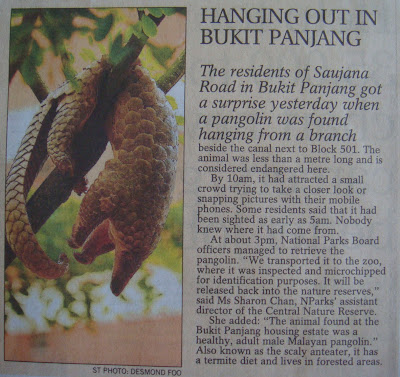I have not been updating about my progress, but much has been going on behind the blog.
After submission of the report, the next task, we UROPS students had, was to prepare an oral presentation of our research project and be examined by two examiners. Supposedly, one would be familiar with the topic of the research, the other should be less familar (according to what Dr. Matthew Lim mentioned in Ecology class today). I got Prof. Peter Ng and Prof. Chou Loke Ming. My Professors for Natural Heritage of Singapore. A lot of people went like, "Wow, two FULL Profs!"
After hanging around as a 3rd year student, I start to hear things like high impact journal articles, prestigious journals (Science and Nature), things I never knew existed at all as a freshmen or 2nd year students It opens your eyes to things. You hear about getting things published. And how that is a goal of the Professors and his or her students, to get things publish, in a reputable journal. :) And you see your lecturers names on journals and all and you go WOW.
Yes, but Prof. Ng (fish and crabs) and Prof. Chou (marine life) are like my "idols", people I really look up to because of the work they have done in the local conservation scene and the passion that exudes out of them when they talk about it in class. [My supervisor, Prof. Tan (native plants) is also another very passionate conservationist.] So I feel really very honoured to have them examine me. Like to be able to have a bit of their time, to pay attention to what I say and question me, is a very precious experience.
Nevertheless, it was painful preparing for it. My lack of confidence, fear and timidity reached its maximum as I hesitated at every step I took. But I am very thankful for my supervisor, mentors and labmates and my friend who gave me moral support and advice. That together with God's grace really pulled me through this difficult period.
I have one more oral presentation to go with Prof. Peter Ng on Wednesday. This time, I hope to be more steady and prepared than when I was with Prof. Chou on Friday. To really give it my best shot.
I need to share the results of my survey with you one day soon. I just realized I have not done so, though that might probably be on your mind.
What do the people of the class I surveyed think about plant species, animal species and natural habitat conservation? Which do they find more important? Or do they have equal concern?
What kind of conservation behaviours do they tend to exhibit? Private kind like educating friends and family and using conservation friendly products? Public kind like volunteering with a conservation club, signing a petition or writing a letter to the newspaper to advocate biodiversity conservation?
What motivates the people in this class to even want to conserve?
What are some predictors of conservation attitudes?
Income? Does being from a richer family cause one to have more pro-conservation attitudes?
Knowledge? Does having more biological knowledge correlate with pro-conservation attitudes?
What about what the student studies in school? Does that affect his conservation attitude too?
Among students taking this module from the various faculties in NUS, which faculty students tend to perform better, and which worse?
Those are some questions I tried to answer in my study and I shall share more really soon.




